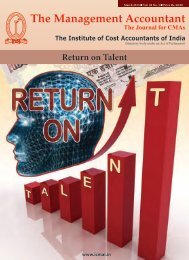This Issue - Icwai
This Issue - Icwai
This Issue - Icwai
Create successful ePaper yourself
Turn your PDF publications into a flip-book with our unique Google optimized e-Paper software.
Target Cost<br />
COST COST ACCOUNTING<br />
ACCOUNTING<br />
ACCOUNTING<br />
The long term financial success of any business<br />
depends on whether its prices exceed its costs<br />
by enough to finance growth, provide for<br />
reinvestment, and yield a satisfactory return to its<br />
stakeholders. As competition increases, and supply<br />
exceeds demand, market forces influence prices<br />
significantly more. To achieve a sufficient margin over<br />
its costs, a company must manage those costs relative<br />
to the prices the market allows or the price the firm sets<br />
to achieve certain market penetration objectives. The<br />
problem that firms face is that the prices are set by the<br />
market forces and the shareholders decide profits.<br />
Therefore firms have no other option but to set the cost<br />
and have to achieve that cost. In the context of these<br />
characteristics, the practice of target costing has<br />
evolved.<br />
Target costing is a fundamentally different way to<br />
look at the relationship of prices and costs. The basic<br />
target equation of “Price—Profit Margin = Cost”<br />
means that prices are driven and set either by<br />
competitive market forces or by the firm as it<br />
aggressively lowers its prices to increase market<br />
penetration; that profit margins are established such<br />
that the firm can make money; and that allowable<br />
costs are derived from price and margin. <strong>This</strong> method<br />
was pioneered by Toyota in the 1960s to achieve high<br />
quality and desirable features at a competitive price.<br />
Target costing is a design approach in which a<br />
company designs a product to achieve a desired profit<br />
while satisfying the customers expectations for quality<br />
and product features. The target costing (TC) practice<br />
(genka-kikaku in Japanese) seeks to bridge the gap<br />
between the cost determined through market research<br />
(i.e., what the customer is willing to pay) and the cost<br />
at which the firm can supply its product, given the<br />
firm’s technology and the state of its accumulated<br />
knowledge, without compromising its profitability.<br />
The balancing of costs, features and quality takes place<br />
throughout the design, manufacturing, sale and<br />
service though it target costing has the strongest<br />
influence during the design phase as the cost<br />
consequences of manufacturing method and features<br />
selected are mostly determined during the design<br />
phase of the product.<br />
Integrating Target Costing with<br />
Supply Chain Management : A<br />
Strategic Perspective<br />
Rajat Gera*<br />
Barnali Chaklader**<br />
The Target Costing approach is illustrated in<br />
Equation I.<br />
The allowable cost is the total product cost which<br />
the firm has to achieve and is dictated by consumer<br />
willingness to pay and market competition.<br />
(Target Cost) = (Selling Price) — (Profit Margin)<br />
Equation I<br />
The desired profit margin is driven by corporate<br />
strategic profit planning. In reality, the allowable cost<br />
might not be achievable in the short run, and the target<br />
cost is revised upward. The target cost estimate is first<br />
determined based on the best estimate of the future<br />
product’s costs and compared with the target cost,<br />
and the gap constitutes the subject of the costreduction<br />
program. The excess of the estimated cost<br />
over the target cost is reduced by management tools<br />
like value engineering. For example, the current cost<br />
estimates of the final product may be INR 100,000<br />
while the target cost determined through market<br />
research and strategic analysis may be INR 80,000<br />
which leads to a target cost reduction of Rs 20,000 ie<br />
20%. The same is achieved by decomposing the gap<br />
into cost reduction targets for various business<br />
functions. Each function then redesigns its component<br />
of the product or re-engineers the manufacturing and/<br />
or logistics process (i.e., JIT = just-in-time) to achieve<br />
the desired target cost estimate. The redesigning<br />
process is called value engineering, which is basically<br />
concerned with looking for alternatives to designing<br />
product with the same or greater level of quality/<br />
functionality while reducing the cost. The process<br />
undergoes numerous iterations before the final<br />
product can be produced within the targeted cost.<br />
Supply Chain Management (SCM) : is a logistics<br />
network which consists of suppliers, manufacturing<br />
centers, warehouses, distribution centers and retail<br />
outlets as well as raw materials, work-in-process<br />
inventory and finished goods that flow between the<br />
facilities. SCM is also defined as a set of approaches<br />
utilized to efficiently integrate suppliers, manufac-<br />
* Associate Professor (Marketing), Institute of Management<br />
Technology, Ghaziabad<br />
** Associate Professor (Finance and Accounting), Institute<br />
of Management Technology, Ghaziabad<br />
The Management Accountant |September 2011 763




